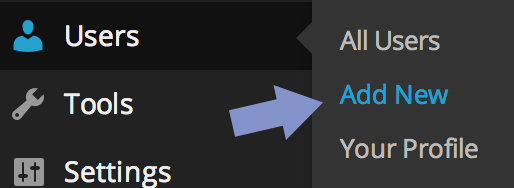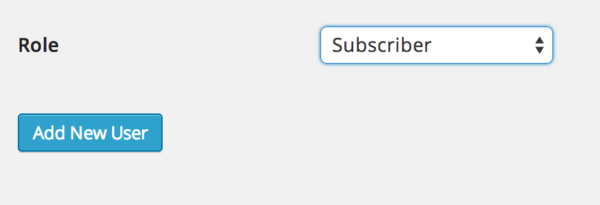
One of the things I love about WordPress is the ability you have as a website owner to create new users. Adding users to your site means you can share responsibilities for creating or editing blog posts, updating product and service pages and adding new pictures without giving full access to the core site functions. As you create new users, it’s important to understand how much access and control each role allows so you can make good decisions about what someone will be able to change or update with your website.
Let’s start with how to add a new user:
– Make sure you are logged into your website
– Hover over the word “Users” on the left hand side of your dashboard.

– Click the words “Add New”

– Next Fill out all the details associated with this user role. Carefully pick the user name. It can not be changed once you create the user. This name will appear whenever they author a blog post on the site.
– The most important part of this page is all the way down at the bottom where you assign the user a specific role based on their responsibilities regarding your website.

Understanding the Roles
The roles are as follows from most to least capabilities.
1. Administrator
2. Editor
3. Author
4. Contributor
5. Subscriber
As you can see creating a new user on your website is a fairly simple task, but understanding the user roles in WordPress and knowing how much power to delegate to an individual can be a bit trickier. These user roles are particularly helpful for associations or organizations where lots of people will be creating content. Users at various levels are free to add information without the ability to access and possibly damage core site functions.
As the website owner, you have the full powers of the Administrator role. It sounds empowering because it is. In the administrator role you literally have access to every feature WordPress has to offer. Plus, administrators are the only ones capable of creating other users.
As you move your way down the chain of command you have your editor who still has some pretty immense powers but cannot embed code or change the structural layout of the website. They can create, edit and publish any pages and posts, upload images to the media gallery and moderate comments. In other words, the ability to alter pages and blog posts which are not their own is really what sets them apart from the author role.
Authors are only allowed to create, edit, delete and publish their own blog posts. They cannot create or edit any pages. Contributors can write and edit their own posts but are not allowed to publish them. Unlike the author role, their post must be approved by the administrator role and after approval is given, the post cannot be changed by the contributor. Quite often you will assign the contributor role to guest bloggers.
Last but not least you have the subscribers. The subscriber role has the least amount of capabilities and is mainly used to provide people who are interested with additional content such as access to a newsletter. If someone subscribes to your mailing list or uses your RSS feed they might also be considered a subscriber.
As you develop your web design plan, give some thought to how user roles will work to manage your website. There are plugins like User Role Editor which allow you to add or subtract capabilities from the various user roles to modify the amount of control for each user. You can always change someone’s role to give them more or less authority. This is helpful to mange content created by a former employee or board member who wrote articles for your blog. The role can be changed from editor to contributor so the articles are still credited to the author, but access is restricted so they can no longer update or change the content.
WordPress can be tricky and is constantly changing. Need a refresher? Download our WordPress 201 guide today:

